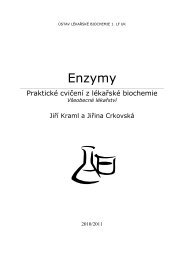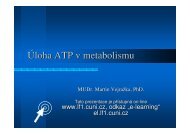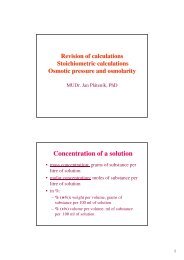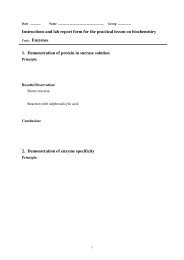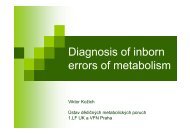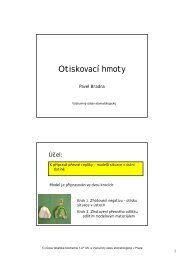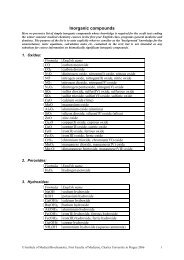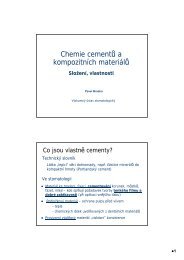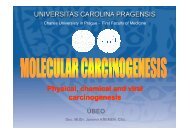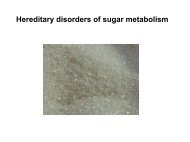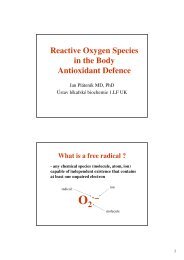(Microsoft PowerPoint - ATP angl.ppt [Re\236im kompatibility])
(Microsoft PowerPoint - ATP angl.ppt [Re\236im kompatibility])
(Microsoft PowerPoint - ATP angl.ppt [Re\236im kompatibility])
- No tags were found...
You also want an ePaper? Increase the reach of your titles
YUMPU automatically turns print PDFs into web optimized ePapers that Google loves.
The role of <strong>ATP</strong> in metabolismMUDr. Martin Vejražka, PhD.This slideshow is available on-linewww.lf1.cuni.cz, link „e-learning“el.lf1.cuni.cz
Adenosin triphosphate (<strong>ATP</strong>)NH 2- O OPNN- O- OPOONONOOPOO -HOOH
<strong>ATP</strong>, ADP, AMP a cAMP Macroergic compound Role in signaling– cAMP– AMP Binds transitive metals RNA
What is macroergic bond???… back to thermodynamics
Thermodynamics Two axioms Abstract quantities (entropy, enthalpy…) Idealised processes and stuffs (reversibleaction, universal gas…) Is not interested in inner structure ofmateria Does not deal with time, rate of processes „Simple“ and „easy to understand“system
Thermodynamic functionsU inner energyH enthalpy = heat contentS entropy = measure of randomnessF free energyG free enthalpyCannot be measured absolutely, changes are quantifiedStandard quantities (G 0 , S 0 …) defined forcertain „standard state“
Enthalpy Constant volume:∆U U = Q∆ inner energy = reaction heat Constant pressure∆H H = Q– a part of energy corresponds tomechanical work
Enthalpy ∆H H … heat exchanged between the systemand its surrounding H … heat content – how much heat can bemaximally produced by the system If volume is not changed: equal to changein inner energy
Free enthalpy A portion of enthalpy can be used toincrease arrangement of the system∆G G = ∆H – T·∆S
Free enthalpyinclinationto react=decreasein energyof system+increase inrandomness ofsystem∆G G < 0 … reaction runs spontaneously∆G G = 0 … equilibrium∆G G > 0 … need for energy
Free enthalpy∆G G = ∆G 0 ‘ +RT·ln[products]/[reactants]∆G 0 … all concentrations 1 mol/l∆G 0 ‘ … + aquaeous sol., pH = 7,0∆G 0 = - RT·ln K‘
Course of reaction∆G G = ∆G 0 ‘ + RT·ln[products]/[reactants]Can run?∆G G < 0Real concentration ofcompoundsProperties of reactionK
Course of reaction∆G G = ∆G 0 ‘ + RT·ln[products]/[reactants]CouplingofreactionsTaking products awayIncreasing reactant concentration
… back to <strong>ATP</strong> …
<strong>ATP</strong> Hydrolysis of <strong>ATP</strong> is stronglyexergonic<strong>ATP</strong> → ADP + P i ∆G 0 ‘ = -30,5 kJ/molThermodynamics: reaction may run spontaneouslyKinetics: reaction does NOT run spontaneously
Hydrolysis of <strong>ATP</strong>without enzymewith enzyme∆G0‘ = -30,5 kJ/mol
Coupling of reactionsheatModified from Murray et al.: Harper‘s Biochemistry
Coupling of reactions<strong>ATP</strong>heatADPADP
Irreversible reactions
Irreversible reactions
How to make <strong>ATP</strong>oxidation of fuelsmitochondriarespiratory chainproton gradient is formedreducing equivalentsNADH, FADH 2phosphorylation of ADP= formation of <strong>ATP</strong>
Other macroeric compoundsPhosphoenolpyruvateCarbamoylphosphateBisphosphoglycerateCreatinphosphate<strong>ATP</strong>ADPPyrophosphatePhosphorylated carbohydratesOther:thioesters (including acetylcoenzyme A)esters of aminoacidsS-adenosylmethioninphosphoribosyl pyrophosphate…
Other properties of <strong>ATP</strong> A complex with Mg 2+ works– Mg is cofactor of all enzyme-catalysedreactions of <strong>ATP</strong>
Some reactions of <strong>ATP</strong> Adenylate kinase<strong>ATP</strong> + AMP ↔ 2 ADP Nucleoside kinases<strong>ATP</strong> + GDP ↔ ADP + GTP


![(Microsoft PowerPoint - ATP angl.ppt [Re\236im kompatibility])](https://img.yumpu.com/46799556/1/500x640/microsoft-powerpoint-atp-anglppt-re236im-kompatibility.jpg)
